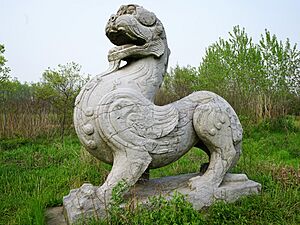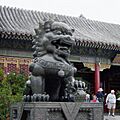Chinese guardian lions facts for kids
Quick facts for kids Chinese guardian lions |
|||||||||
|---|---|---|---|---|---|---|---|---|---|
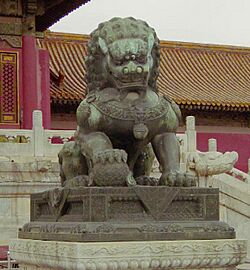
A Ming-era guardian lion in the Forbidden City
|
|||||||||
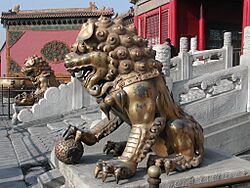
A Qing-era guardian lion pair in the Forbidden City. Note the different appearance of the face and details in the decorative items, compared to the earlier Ming version.
|
|||||||||
| Chinese name | |||||||||
| Traditional Chinese | 獅(子) | ||||||||
| Simplified Chinese | 狮(子) | ||||||||
| Literal meaning | lion | ||||||||
|
|||||||||
| Alternative Chinese name | |||||||||
| Traditional Chinese | 石獅(子) | ||||||||
| Simplified Chinese | 石狮(子) | ||||||||
| Literal meaning | stone lion | ||||||||
|
|||||||||
| Khmer name | |||||||||
| Khmer | សឹង្ហ singha |
||||||||
| Thai name | |||||||||
| Thai | สิงห์ sǐng |
||||||||
| Sinhala name | |||||||||
| Sinhala | සිංහ siṁha |
||||||||
| Sanskrit name | |||||||||
| Sanskrit | सिंहः sinha |
||||||||
| Burmese name | |||||||||
| Burmese | ခြင်္သေ့ chinthe |
||||||||
| Tibetan name | |||||||||
| Tibetan | གངས་སེང་གེ gangs-seng-ge |
||||||||
Chinese guardian lions are special statues often seen at the entrances of important buildings in China. People also call them imperial guardian lions or stone lions. In English, you might hear them called lion dogs or foo dogs. These lions are usually made of stone and come in pairs. They were first popular in Chinese Buddhism.
People believed these statues would protect buildings from bad spirits and harmful people. They were used in old Chinese palaces and tombs. Over time, these guardian lions became popular in many other Asian countries too, like Japan, Korea, and Thailand.
Contents
What Are Guardian Lions?
Statues of guardian lions have always stood in front of important Chinese buildings. These include old palaces, tombs, government offices, and temples. Rich families also placed them outside their homes. People believed these lions had strong magical powers to protect.
You can also find them on door-knockers and pottery. Today, you still see pairs of guardian lions. They stand at the entrances of restaurants, hotels, and shops. This is common in China and in Chinatowns around the world.
The lions are always shown in pairs. One is a male lion, and the other is a female. The male lion rests his paw on an embroidered ball. This ball can mean power over the world. The female lion has a playful cub under her paw. This represents caring for new life.
Names for Guardian Lions
These guardian lions have different names depending on the language. In Chinese, they are simply called shi. This word means "lion." The word shi might come from the Persian word šer.
Lions first came to China from Central Asia. This was during the Han dynasty. By the 6th century AD, people already used them as guardian figures. Today, people often name them by what they are made of.
- Stone lion (Chinese: 石獅; pinyin: Shíshī): for a sculpture made of stone.
- Bronze lion (Chinese: 銅獅; pinyin: Tóngshī): for a sculpture made of bronze.
Sometimes, they are called:
- Auspicious lion (Chinese: 瑞獅; pinyin: Ruìshī): This name refers to the Snow Lion from Tibet. It also means good luck.
Names in Other Asian Cultures
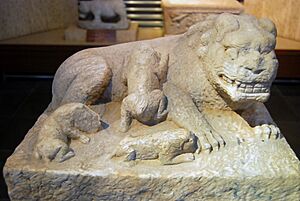
Guardian lions are known by different names across Asia:
- In Cambodia: Singha or Sing (សឹង្ហ).
- In Japan: Shishi (獅子, meaning lion) or Komainu (狛犬, meaning Korean dog).
- In Korea: Sanye (狻猊).
- In Myanmar and Laos: Chinthe.
- In Okinawa: Shisa.
- In Sri Lanka: Singha (සිංහ මූර්ති).
- In Thailand: Singha or s̄ingh̄̒ (สิงห์).
- In Tibet: Snow Lion or Gangs-seng-ge (གངས་སེང་གེ་).
- In Vietnam: Sư tử đá.
- In India: Sher, Singha, or Chinggam (शेर, সিংহ, or சிங்கம்).
Western Names
In English, guardian lions are often called "Fu Dogs" or "Foo Dogs." They are also known as "Fu Lions" or "Lion Dogs." The word "Fo" or "Fu" might come from Chinese words meaning "Buddha" or "prosperity." However, Chinese people rarely use these words with guardian lions. They never call them "dogs."
Westerners might call them "dogs" for a few reasons. In Japan, they are sometimes called "Korean dogs." This is because the lions came to Japan through Korea. Also, some people might confuse them with Chinese dog breeds. These include the Chow Chow or Pekingese, which are sometimes called "lion dogs."
How They Look

Guardian lions are usually carved from beautiful stone. Marble or granite are common choices. They can also be made from bronze or iron. These materials and the carving work were very expensive. So, only rich or powerful families could afford them. Having guardian lions showed a family's wealth.
Today, you can find cheaper lions made from concrete or resin. This means more people can have them.
The lions always come in pairs. This shows the idea of yin and yang. The female lion represents yin, and the male represents yang. The male lion has his right front paw on an "embroidered ball." This ball often has a cool pattern. The female lion looks similar. But she has a cub under her left paw. This shows the cycle of life.
The female lion protects the people inside the building. The male lion guards the building itself. Sometimes, the female has her mouth closed, and the male has his open. This can mean saying a sacred word. In Japan, it means the male breathes in (life) and the female breathes out (death). Other lions have a large pearl in their mouths. The pearl can roll around but is too big to be removed.
According to feng shui, placing the lions correctly is important. When you look at the entrance from outside, the male lion with the ball is on the right. The female lion with the cub is on the left. In some South Asian temples, lions are placed at entrances. This protects the sacred space from bad energy.
Chinese lions show the feeling of a lion, not how a real lion looks. Their claws, teeth, and eyes show power. You usually don't see many muscles on Chinese lions. This is different from English lions, which look very realistic.
History of Guardian Lions
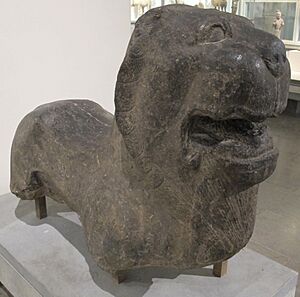
People believe that Asiatic lions are the type of lions shown in Chinese guardian statues.
Lions first came to China during the Han dynasty. This happened through trade and cultural exchange along the Silk Road. People from Central Asia brought lion pelts and live lions to China. They also shared stories about them.
Ancient Chinese writings mention lions being given as gifts. For example, in 87 CE, an envoy from Parthia gave a lion to the Han court. Chinese people linked lions to other respected mythical creatures. A monk named Huilin said that the mythical suan-ni was actually the lion. He said it came from the "Western Regions."
Over time, guardian lions changed their look. Different periods and regions in China had their own styles. Some lions looked fierce, while others looked calm. During the Ming and Qing dynasties, their appearance became more standard. This is how they mostly look today.
Images for kids
-
A horn blower riding a guardian lion, Qing dynasty
-
One of the many old Foo dogs at San Agustin Church (Manila) in the Philippines.
-
One of the foo dogs at Basilica del Santo Niño in the Philippines. The foo dog pair in the church are both male, similar to other churches in the islands.
-
A sitting lion statue, celadon, 11th to 12th century, Song dynasty
-
Green guardian lions, Ming dynasty
-
Female guardian lion with her cub at the Summer Palace, Beijing- late Qing dynasty, but in the Ming style
-
Standing lion at the Ming dynasty tombs Spirit Way
-
Imperial guardian lion outside Ngee Ann City in Singapore
-
Guardian Lion outside the Green Palace, Ulaanbaatar, Mongolia
-
Guardian Lion, Brooklyn Museum, New York City
-
Guardian Lion in Saint Petersburg, Russia
See Also
- Komainu: Learn about similar guardian statues in Japanese culture.
- Kanglā Shā: A similar guardian figure in Meitei culture.
- Lamassu
- Qilin: Another mythical creature from Chinese culture.
- Sphinx
- Chinthe: Similar lion statues found in Burma, Laos, and Cambodia.
- Shisa: Similar lion statues from the Ryukyu Islands.
- Nian: Compare with a similar mythical beast that has a horn.
- Pixiu: Compare with a similar mythical beast that has wings.
- Haetae: Learn about similar lion-like statues in Korea.
- Foo dog: Chinese dog breeds that look like guardian lions.
- Asiatic lions: The type of lions thought to be shown in Chinese culture.
- Nghê: Creatures with similar roles to Chinese guardian lions in Vietnamese culture.
- Piraeus Lion
- Tibetan Snow Lion
- Traditional Chinese Lions (Indianapolis Zoo)
- Medici lions
- Lion dance: Another way lion imagery is used in costume and dance.
- Culture of China
- Chinese mythology
- Chinese dragon
- Door god


